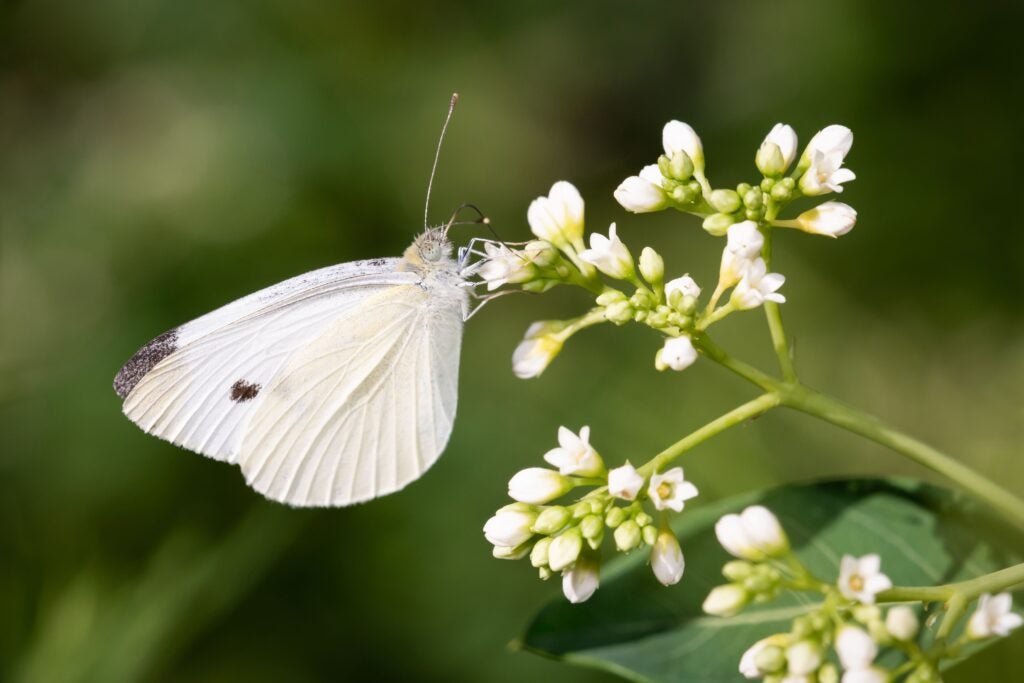Invasive Insects: Examining the Spread of The Cabbage White Butterfly
A look at Earth Commons affiliated faculty member Professor Judith Miller’s latest ecological research.
By Maya Snyder, SFS ‘24 & Common Home Editor

How do invasive species spread? Professor Judith Miller, a Georgetown professor in the Department of Mathematics and Statistics focusing on mathematical models, hopes to answer this critical question with her research. Dr. Miller studies the genetics of invasive species and how they adapt– or fail to adapt– to the new environment they are invading.
One of Dr. Miller’s recent projects focuses on the spread of the Cabbage White butterfly in eastern North America. It is a collaboration with a team including Georgetown faculty members Leslie Ries, Naresh Neupane, Mariana Abarca (now at Smith College), undergraduate student Jackson Foran (COL ‘22), and several other researchers.
The research investigates two main questions. First, what are the factors that explain how this butterfly spread in North America during the 19th century? And second, how did genetics and adaptation– or the failure to adapt– to new environments affect the speed and ultimate extent of the spread?
The team employs a mathematical model to examine how the species spread in North America. To dive into how it works, we sat down with Professor Miller.
“There are many kinds of mathematical models. The kind of models that I do most of my work with are called deterministic evolutionary models,” Dr. Miller explained. “‘Evolutionary’ in this context doesn’t refer to Darwin, it means changing in time. In mathematics, if you know the state that a system is in right now, you can solve evolution equations to figure out what states it will be in the future.”
“In mathematics, if you know the state that a system is in right now, you can solve evolution equations to figure out what states it will be in the future.”
Professor Judith Miller
To illustrate their usefulness, Professor Miller proposed an example. “Say you have a hypothesis that a type of species had to adapt to a dry environment in order to spread into this new terrain. You can make a mathematical model that doesn’t allow adaptation to take place. If computer solutions of the model show the species invading new territory anyhow, then maybe adaptation isn’t crucial to the species’ expansion. If not, you can try models that do allow adaptation to see if their solutions come closer to what’s been observed in the field. You can explore models that incorporate certain hypotheses about, say, what kind of genetic architecture crucial traits have. Then you can see if those plausibly explain the spread of the species.”
In short, mathematical models allow you to make predictions and confirm hypotheses– a powerful tool in the field of spatial ecology.
In their research on the Cabbage White butterfly, Dr. Miller and her team compare the predictions of their model with a map showing the actual spread of the species during the time of their study. They are currently testing the model under the null hypothesis that there was no adaptive evolution involved. “We have some very interesting preliminary results, suggesting that it is difficult to explain the spread to Canada without relying on adaptation to a colder climate up north,” Miller noted.
Alternatively, establishing that there was adaptive evolution is more complicated. “To understand evolution, well, that involves how certain traits change. And to understand what the evolutionary pressure will be on the trait to change, you have to understand what would be the best possible form for that trait to take in terms of fitness,” Professor Miller explained. “For instance, if it’s a flower, what’s the absolute best time for the plant to bloom so that it will be fertilized and spread its seed and propagate the most offspring?”
The research process is further complicated by the project’s geographical scope. “For a huge geographical area, how are you ever going to do a field study to get that information?”
Professor Miller and her team proposed a solution. “An idea that we had was that, there’s so much more climate data available than there is about any trait in a given species. When we think that fitness is very closely related to being well adapted to climate, hopefully incorporating all that climate data into a model will allow you to infer what the best trait values are over these huge areas and possibly large stretches of time.”
Where there was once no hope of determining the role of adaptation from any feasible field study, Professor Miller and her team are now able to continue their investigation with greater depth and more accuracy than ever before.
***
Special thanks to the Massive Data Institute for helping make this research possible.
In 2023, Professor Miller will be at the Institute for Advanced Study—Nantes where she is jumpstarting a project involving social networks and their influence on landowners willingness to take measures against invasive species. If you’re interested in reading more about her research projects, you can access her Georgetown faculty page here.
